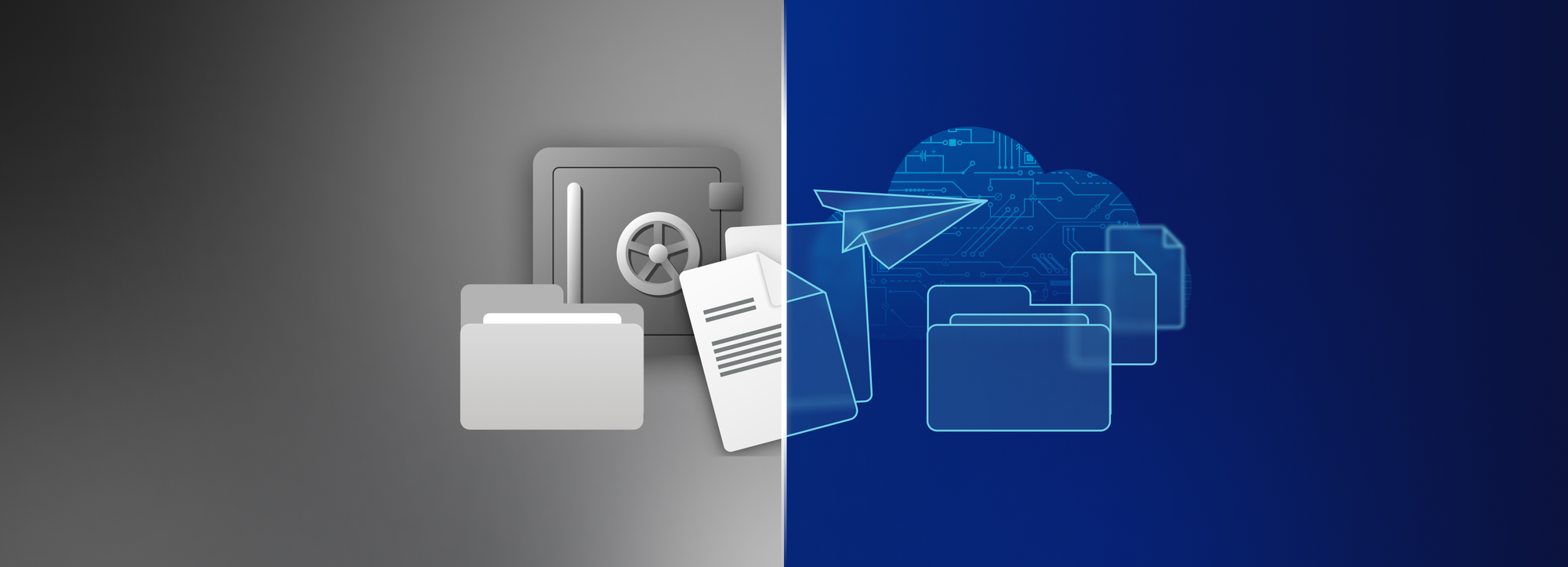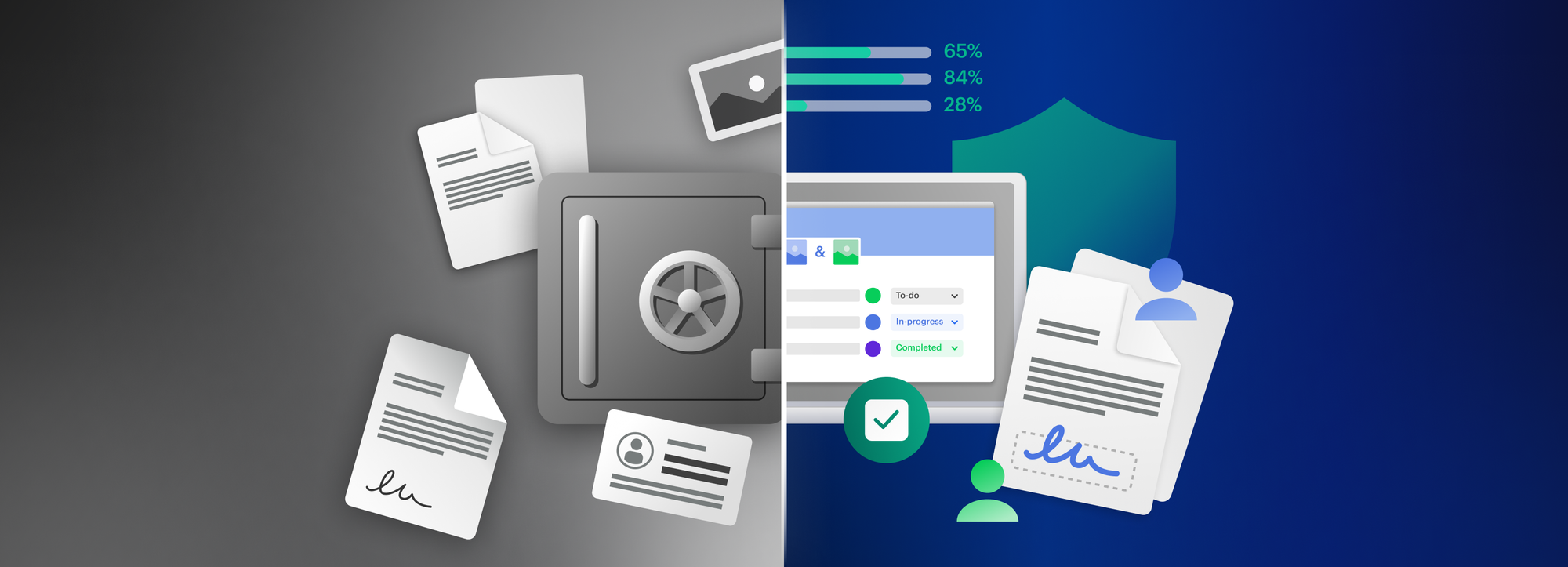Is Intelligent information management what's next for Enterprise Content Management?

Enterprise Content Management (ECM) systems are invaluable to Enterprises. They create order and efficiency in the chaos of paper-based documentation and digital resources. They have also led to further technological leaps in enterprise governance and quality assurance. Today, physical formats are almost entirely a thing of the past, and all administration is expected to be done online. With little need to manage printed documents, it's no surprise that cloud solutions have taken the space by storm. However, not all tools offer the functions expected from an ECM. And more importantly, what compromises do they make on cybersecurity?
Keep reading for a deep dive into what ECM systems meant in the past and what their future holds. Learn about their benefits for enterprises and why end-to-end encrypted storage solutions, like Tresorit, are great for securing enterprise content in the cloud.
What is enterprise content management?
Enterprise content management is mainly referred to as document management or records management. It is the process of managing the entire lifecycle of an organization's content, including docs, spreadsheets, PDFs, and images.
When all industries relied on paper, physical documents were the most important content medium a company had to store securely, organize, preserve, and distribute. Invoices, resumes, correspondence and contracts had to be processed (discussed, validated, approved, etc.) and routed between several parties, then later archived or even destroyed safely.
But business-critical content now encompasses much more than just paper documents. Videos, presentations, audio files, pictures, social media posts, emails, website content, spreadsheets, and digital documents are invaluable assets essential to performing daily tasks. With everything becoming increasingly interconnected, cloud-based solutions are needed to enhance collaboration. It can also be a challenge to identify, label, and group different types of information based on their importance or sensitivity.
Essentially, enterprise content management now handles the lifecycle of business-relevant content through a collection of defined processes, methods, strategies, and tools. In addition, the software tools and storage methods used for these purposes have moved from locally installed software to more flexible cloud solutions. This allows a company to effectively capture, process, organize, manage, store, archive, and distribute all digital business-critical information to its employees, stakeholders, and customers in an online environment.
Why is enterprise content management important to an organization?
Businesses deploy enterprise content management technology to increase efficiency, improve information control, accessibility and security, and foster collaboration. Moving from paper-based documentation to a centralized ECM system naturally had sustainability benefits and, when done right, could also be a cost-saving measure. ECMs can also automate several workflows and processes to improve company efficiency.
What what are the main benefits of ECM?
- Cost-saving: Minimizing paper documentation and local storage needs for digital information can lead to major cost-saving. Having the tools to handle document retention automatically and maintain access and changelogs can help maintain compliance and thus avoid major fines. Cloud solutions offer more flexible and cheaper means for data storage needs.
- Productivity: ECM can quickly handle large amounts of data and simplify storage and distribution logistics. They can reduce document duplication, unintended loss, and unintended changes made to content. Manual business processes can be automatized so employees can concentrate on critical tasks.
- Security: Digital storage spaces with their role-based access controls and encryption methods ensure that information stays private, privileges (who can edit, only read, share, delete) are controlled, and changes made to content can be traced. Better auditability builds trust with customers and regulators alike.
- Compliance: Comply with government and industry regulations such as GDPR, HIPAA, the Sarbanes–Oxley Act, PCI DSS, FINRA, TISAX, CCPA, ITAR through proper classification of information in the content (personal, information, sensitive personal information, business-sensitive information, and public) and applying restrictive access controls (read-only, edit, share, etc.) and of course encryption.
- Decision making: Improved decision-making processes through data analytics, search functions, and automated processes.
- Accessibility: ECM provides data search and analytics tools. They can empower cooperation in a genuinely global and remote workforce by ensuring employees can access the files they need at any time, on any device. ECM can also improve services to RFIs (request for information).
- Satisfied Customers: Content is shared not only inside a company but also outside. Customer services, e.g., resolving issues, informing, notifying, availability, order handling, are all improved by an ECM system.
- Business continuity and recovery: A thought-out, redundant ECM platform offers businesses high availability and reduced downtime in case of a service disruption as it entails archives, backups, and disaster recovery.
The main features of ECM you should be familiar with
On average, employees will fail to find the information they need 46% of the time. The root cause is that content is usually spread across multiple, disconnected systems and sites. Today, a vast amount of content must be available to thousands of employees and even a few third parties instantly in an enterprise environment.
As a result, ECM systems, encryption solutions, and cloud services are becoming more important day by day. Employees may need live collaboration without the integrity of a file being damaged. Versioning is also an issue: a technical requirement and a regulator demand. Avoiding duplicates and being able to revert to previous file versions is a vital need for many corporations. Employees working in teams, groups, and on different projects should have dedicated workspaces for security and efficiency.
Today, all the above can be achieved easily – with the right tools. End-to-end encrypted cloud storage solutions, such as Tresorit, for example, provide role-based access controls with version and access monitoring. These can help ensure that information stays private, privileges (who can edit, read-only, share, delete) are controlled, and content changes can be traced.
ECM is an umbrella term for various software, tools, processes that must integrate with many other platforms. Standard business tools like CRMs (customer relation management) and ERPs (enterprise relation management) are primary examples. APIs can integrate with many other services but can pose a security risk if implemented incorrectly. Cloud-based ECM solutions integrate well with other cloud services. Choosing the correct tools can drastically improve security. End-to-end zero-knowledge encryption is a great place to start.
ECM keeps track of policy (company or government) changes and notifies users to adjust their work or content accordingly. Automating mundane manual tasks with a customizable set of defined steps enables companies, for example, to handle document routing, notification and ease approval procedures.
Auditability is also a key factor in risk management and compliance. With a sophisticated ECM solution, every modification and activity in the system is tracked, evidence can be retained for required periods. A single, reliable source of evidence is crucial to demonstrating compliance with industry standards and national or regional regulations. In addition, monitoring and analyzing business processes and workflows helps employees understand usage patterns and enables a company to learn from mistakes and increase efficiency.
Does enterprise content management have a future?
Back in 2017, the Association for Information and Image Management (AIIM) proposed changing the name of "enterprise content management" to "intelligent information management." IIM was defined as "the strategies, methods, and tools used to create, capture, automate, deliver, secure, and analyze content and documents related to organizational processes. IIM refers to managing content and data, not just content itself."
Thus, the future of enterprise content management lies in machine learning, cloud technology, quantum computing, and increased mobile capabilities. Moving to the cloud with ECM ensures that unstructured content (information that doesn't have a predefined format, e.g., Office documents, PDFs, and emails) is enhanced with metadata. This makes them searchable, shareable, and editable by multiple people simultaneously from anywhere on any device. In addition, companies with multiple sites across the globe will benefit from a single centralized repository, where business processes are also brought to a common ground, resulting in increased efficiency.
Structured data (information contained and defined, like databases and code repositories) will benefit from AI technologies that monitor and analyze content for errors or duplications. Many business processes can be automated for HR: contracts management, accounts payable automation, routing material for approval, handling tickets and invoices on time. AI technology can also be used to understand how people interact with content. By extension, this influences how we work and help make processes more efficient.
Tresorit provides several solutions that enable businesses of any size to explore secure ways to enhance their content management framework. Tresorit's Secure Cloud is a reflection of the future of work. As enablers of a hybrid workforce, they connect teams while keeping them secure and provide instant access to company data in a centrally controlled way.
The ever-growing number of connected devices, remote access, stricter data protection regulations, insecure WIFI, and mobile devices require that security becomes integral to next-gen ECM solutions.
With Tresorit, all company data is protected through true end-to-end encryption. This means that no one, not even Tresorit, can access your files until you choose to share them. This can be done with shared folders for teams and secure sharing links. When shared, files can be secured with passwords, link expiry dates, virtual watermarks, and blocking downloads. In addition, admins can enforce selected settings on a per-role or even company level to ensure maximum security. These features help companies mitigate the human factor, one of the most significant security risks.
Tresorit syncs shared folders between all users' devices, so you can rest assured that everyone is working on the newest version of a given file. With Tresorit's document analytics, you'll be able to leverage metadata by tracking how recipients engage with the documents you share. Essentially, document analytics provide an additional layer of insight and security into who is interacting with your documents and how. Learn more about how you can leverage Tresorit within your content management system.






